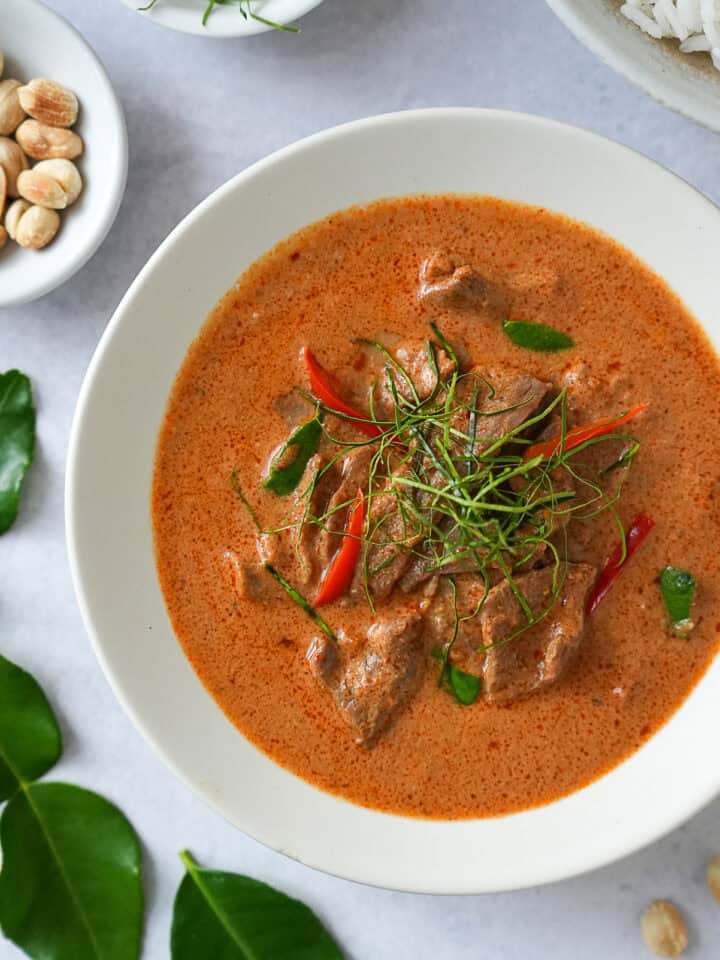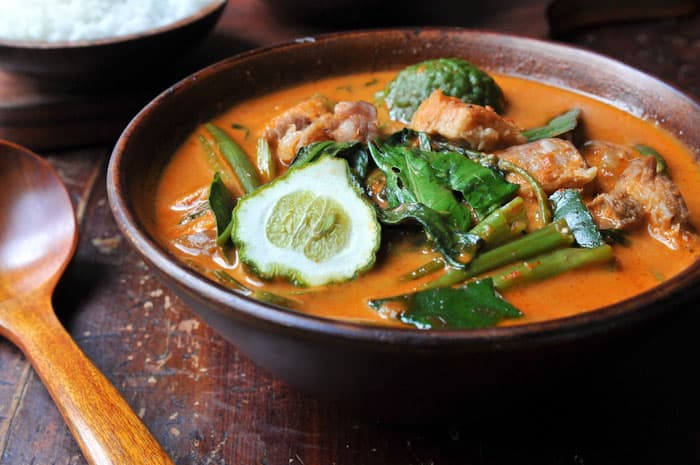Kaffir lime leaves (also known as makrut lime leaves) are an absolutely essential herbal ingredient in Thai cuisine. Read on to learn more about these fragrant leaves, including what they are, how they're used, and where to find them.

Kaffir limes (makrut) and kaffir lime leaves (bai makrut) are two herbal ingredients that are so well incorporated into the landscape of Thai cooking that it's very likely you’ve eaten them, even if you’ve never heard of a kaffir lime tree. Whether you're making a classic Thai curry, a hot and sour soup, or a savory stir-fry, these aromatic leaves are indispensable for achieving that authentic Thai taste.
In contrast to many other citrus fruits, kaffir or makrut limes have a very distinctive, almost astringent lime flavor. This unique flavor is often used in combination with other herbs, such as lemongrass and galangal, to create a complex flavor profile that makes Thai dishes so delicious. If you're unfamiliar with them, or if they’re hard to find, don’t worry. I'll guide you through the ins and outs of using these distinctive limes so you can prepare delicious and authentic Thai food from the comfort of your own home.
Jump to:
Kaffir Lime vs Makrut Lime
Kaffir lime and makrut lime are two names for the same plant. In English, the term "kaffir" is used, while in Thai it is known as "makrut" (มะกรูด, pronounced ma-groodt).
However, use of the term "kaffir" has recently fallen out of favor, as it sounds similar to a racial slur in South Africa. Therefore, moving forward, I will primarily use the Thai name. You may still come across some of my non-updated recipes with the old name. Since the shift in naming preference is relatively recent, you will likely find these limes and leaves labeled as "kaffir" in other recipe sites, cookbooks, and grocery stores.
What are Makrut Limes?
Makrut limes and makrut lime leaves come from the makrut lime tree. This tree is also known as kaffir lime tree, Thai lime tree, or by its scientific name, Citrus hystrix. It is native to tropical Southeast Asia where it grows as a thorny shrub or small tree, reaching heights of approximately 5 to 30 feet.

Once you know what to look for, makrut limes and makrut lime leaves are instantly recognizable. Makrut lime leaves are a vibrant shade of green with a nice sheen to them. These leaves are double-lobed, making them appear as though two leaves are joined end-to-end. The unique fragrance and flavor of this plant is present in the leaves, and even more intense in the lime.
Makrut limes are slightly smaller than typical limes, roughly about 2 inches wide. They are a light to medium shade of green. The rinds of these limes are very bumpy and wrinkled in appearance, looking like what you might imagine a brain looks like. If you cut a makrut lime open, you will find the rind is very thick, there are many seeds, and the fruit does not have much juice.

What do Makrut Limes and Leaves taste like?
Makrut limes and leaves have a very distinctive fragrance and flavor. It is overwhelmingly citrusy and floral at the same, almost reminiscent of a combination of lemongrass, citronella, and jasmine. If you rub a makrut lime leaf between your fingers, you can appreciate this unique aroma. The lime zest is also very fragrant, while the lime juice tends to be quite sour and somewhat bitter. No other citrus fruit has quite the same flavor as the makrut lime.
How is Makrut Lime used in Thai Cooking?
Both the limes and the leaves of the makrut tree are used in Thai cooking, although the leaves are used more often than the limes. The leaves are used to infuse their flavor into liquids, and can also be eaten in small pieces. The lime is most often used for its zest, not its juice.
Leaves: Infuse into liquids
Makrut lime leaves are most often used as an herbal aromatic in soups and curries. The central vein is removed and the leaves are torn before adding them to the liquid. This helps them to release their flavor more readily as they cook. The leaves are typically removed before serving, or they can be removed by diners as they eat. Torn makrut lime leaves are a key ingredient in many popular Thai soups such as Tom Yum Goong and Tom Kha Gai, as well as curries like Gang Keow Wan and Gang Ped to name a few.
Leaves: Thinly slice
Makrut lime leaves are edible when torn into small pieces, or when they are sliced very thinly. A chiffonade cut is often used for Thai dishes. Thinly sliced makrut lime leaves are added to some fresh soups and salads such as Pla Goong and Shredded Chicken and Lemongrass Soup, stir fries such as Pad Prik King and Kua Kling, and even some curries like Panang Curry.
Lime: Shred the Zest
The zest of the makrut lime is preferred over leaves when making pastes, as it is easier to break down in a mortar and pestle. Many Thai curry pastes include makrut lime zest. The zest is also particularly useful when making Thai-inspired desserts such as Kaffir Lime Cake and Kaffir Lime Tarts. Whole makrut limes are featured in certain dishes, such as Gang Tay Po, a red curry simmered with pork belly and water spinach.
The juice of the makrut lime is not often used, because it can be quite acidic and somewhat bitter. However, it is featured in select dishes such as this Grilled Prawn Salad. The astringency of makrut lime juice lends it to being used as a shampoo, detergent, or household cleaner in Thailand more often than using it in cooking.
How to Finely Slice Makrut Lime Leaves
When you want to infuse the flavor of the makrut lime leaf into a liquid, simply break the leaves apart from each other and remove the central vein from each side. The leaves can then be torn into smaller pieces.
When you're wanting to cut makrut lime leaves finely to add to salads, curries, and stir fries, it's easiest to use a chiffonade cut as detailed in these step-by-step pictures.

Step 1: Break the double-lobed leaves apart from each other with your hands. They will come apart easily with slight pressure.

Step 2: Remove the central vein from each separate leaf. You can fold it in half at the vein to make it easier to remove.

Step 3: Stack the leaf halves on top of each other. Then roll them tightly together until the leaves form a cylinder.

Step 4: Slice the leaves perpendicular to the roll with a sharp knife. The thinner you can slice, the more beautiful the presentation!
Where to Find Makrut Lime Leaves
Fresh makrut lime leaves can often be found in groceries that cater to the Southeast Asian population. They may be in the fresh produce section or in the refrigerated section. Sometimes these leaves can be found in pan Asian markets like Ranch 99. I have even occasionally seen fresh makrut lime leaves at Whole Foods and other gourmet specialty stores in my area.
If you're not able to find fresh leaves, look for them frozen. They are not quite as aromatic as fresh, but they still work quite well for Thai cooking. In fact, when I have lots of fresh leaves, I often store them in the freezer to keep.
If you don't have access to fresh or frozen makrut lime leaves, you may want to consider growing your own makrut lime tree. Having your own tree allows you access to fresh makrut lime leaves any time you like!
Storing Makrut Lime Leaves

Makrut limes and makrut lime leaves are most flavorful and aromatic when they are fresh. They will last for a week or two in the refrigerator before drying out and turning brown.
If you need to store makrut lime leaves longer than this, you should freeze them. Frozen makrut lime leaves are not quite as fragrant as fresh, but they still work perfectly well for Thai cooking. Simply wash the leaves and dry them well. Then place them in a freezer safe bag before freezing. You can remove a few leaves at a time for use in recipes as you need them. Makrut lime leaves stored in this manner will keep for many months. Whole makrut limes can also be stored in the freezer for many months, although the lime juice does tend to become more bitter once frozen.
Kaffir Lime Leaves Substitute
Makrut lime has such a unique flavor that unfortunately there is no great substitute for it. However, if you are not able to find fresh or frozen makrut lime leaves, here are three possible alternatives:
- Use Dried Makrut Lime Leaves: Dried makrut lime leaves are more readily available than fresh leaves, but they lack the compelling flavor and fragrance of fresh or frozen leaves. They work best when using to infuse into liquids such as soups or curries, where they'll have time to rehydrate and release their aroma into the broth.
- Use A Seasoning Paste or Packet: There are many seasoning pastes and packets that contain makrut lime leaves and zest as one of the ingredients. If you're not able to find fresh or frozen leaves, you may want to consider making your dish with an all-in-one flavoring paste or powder.
- Use Regular Lime Zest: The zest of a typical lime will give you a nice citrus aroma, even though it's not the same fragrance as makrut lime.
None of these alternatives is a great substitute for fresh or frozen makrut lime leaves. So I'd really encourage you to spend the extra time and effort to seek out the real deal when you're making Thai dishes that call for it.
FAQs
Yes, kaffir lime leaves are edible. They are a key ingredient in some Thai soups and curries. Many diners choose to remove or eat around these leaves, but they are edible. Leaves that have been sliced finely are also edible, and are included in various Thai salads and stir fries.
Kaffir lime leaves have an unmistakable flavor and aroma. They are incredibly citrusy but also have strong floral notes. They taste a bit like a combination of lemongrass, citronella, and jasmine.
Unfortunately there is no good substitute for kaffir lime leaves. Fresh or frozen kaffir lime leaves are best to use in recipes that call for them. Dried kaffir lime leaves can be used in Thai soups and curries in a pinch. Packaged seasoning packets that contain makrut lime leaves, or the zest of a typical lime could also be considered as substitutes. However, nothing can really compare to fresh or frozen kaffir lime leaves.
Yes, makrut and kaffir lime leaves are the same. Kaffir is the English word for this plant, and makrut is the Thai word for this plant. The term kaffir has recently fallen out of favor due to its similarity to a racial slur in South Africa, therefore, the Thai word makrut is the preferred name for this plant.

Makrut limes and their fragrant leaves are truly at the heart of Thai cuisine, imparting their unmistakable citrus aroma and flavor to a variety of dishes. Whether you're simmering a curry, tossing together a salad, or making a flavorful soup, these vibrant leaves add an authentic Thai flavor that's hard to replicate.
Craving more? Subscribe to Rachel Cooks Thai to get new Thai recipes delivered straight to your inbox! And stay in touch on Facebook, Pinterest and Instagram for all of the latest updates.


















Leave a Reply